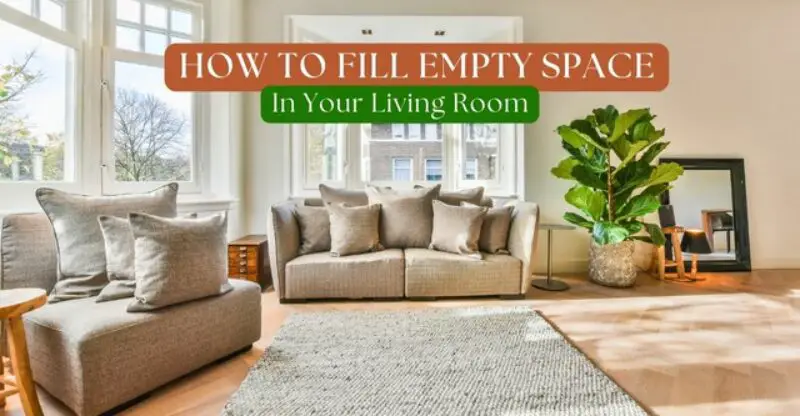9 Unique Ways on How to Fill Empty Space in Your Living Room
Have you ever walked into your living room and felt something was missing? Like a beautifully made-up face with a single blemish, an empty space in your living room can be quite noticeable, especially when the rest of your home is tastefully decorated.
It’s a common issue many of us face, whether due to budget constraints, an abundance of furniture leading to clutter, or simply not knowing how to utilize the space effectively.
But don’t worry, you’re not alone in this. Many homeowners and DIY home improvement enthusiasts face the same challenge. The good news is, that there are creative and budget-friendly ways to transform that empty space into something beautiful and functional.
In this blog post, we’ll explore why this issue of empty living room space is so common and provide practical solutions to help you overcome it.
1 – The Art of Using Furniture to Fill Empty Spaces
Furniture is the heart of any living room. It’s not just about aesthetics; it’s about creating a space that feels good and is comfortable to use. After all, the living room is often the most used area in a home, a place where we relax, entertain, and create memories.
Note: This website is supported by readers and if you click on our links we may earn a commission and as an Amazon Associate, we earn from qualifying purchases.
One effective way to fill up empty space and add functionality to your living room is by incorporating furniture pieces like bookshelves or storage units.
For instance, options like the VASAGLE Industrial Ladder Shelf or the Bush Furniture Salinas Accent Storage Cabinet, not only fill up space but also provide additional storage for your belongings.
For smaller living rooms, a sectional couch or a chaise lounge can be a game-changer. These pieces can fill up empty spaces without making the room feel cramped.
According to a survey by Furniture Today, 67% of consumers said they were happy with their living room furniture. This satisfaction comes not just from the aesthetic appeal but also from the ergonomic benefits that well-placed furniture can provide.
2 – Decorative Tables: A Stylish Solution
Tables are more than just functional pieces of furniture; they can be the stylish solution to filling empty spaces in your living room. With the right table, you can transform an empty area into a focal point that enhances your room’s decor.
Consider a console table, for instance. These long, narrow tables are perfect for filling up an empty wall. Decorate it with vases, picture frames, or other decorative items to create a visually appealing area.
A great option is the Rustic Console Table, which pairs a sturdy wooden top with a black metal frame for a modern industrial look.
For smaller spaces, a side table can work wonders. Perfect for corners, side tables can display decorative items like books, candles, or small plants, adding personality to your room.
If functionality is a priority, a coffee table can be a great addition. It fills up empty space and provides a surface for drinks, snacks, and other items.
3 – Utilizing Wall Art and Decor to Enhance Empty Spaces
Empty walls can often make a room feel incomplete, almost uninviting. But with the right wall art and decor, these spaces can be transformed into captivating focal points that enhance the overall ambiance of your living room.
Wall art, for instance, is a fantastic way to add a pop of color and personality to your space. Whether your preference leans towards abstract paintings, landscape photography, or vintage posters, there’s a piece of wall art that fits your style and budget.
You could opt for a large statement piece to draw attention or arrange a series of smaller pieces on a gallery wall for an eclectic look. For DIY enthusiasts, creating your own wall art from materials like canvas, paint, or even old book pages can be a fun and rewarding project. For inspiration, consider this set of six Gallery Wall Art.
4 – Adding Shelves for Functionality and Style
Empty walls in your living room present an opportunity. By adding shelves, you can fill these spaces while also enhancing the room’s functionality and style.
Shelves offer a platform to display decorative items, store books, or even hold electronics, turning an empty wall into a practical and visually appealing feature.
There’s a variety of shelves to choose from, each with its unique benefits. Floating shelves, for instance, are a popular choice.
They don’t take up any floor space and can be installed at any height, offering a clean, modern look. Bookshelves are ideal for those with a large collection of books or for displaying items alongside your books. Corner shelves, on the other hand, are perfect for utilizing unused corner space.
To maximize the functionality of your shelves, consider adding storage baskets or bins for smaller items. This not only helps keep your shelves organized but also adds a pop of color and texture to your living room.
Adding shelves to your living room not only fills empty spaces but also offers numerous benefits. It makes items easier to find, saves time, gives a structured look, utilizes vertical space, and provides storage and display options.
5 – The Magic of Mirrors in Expanding Your Space
Mirrors are more than just reflective surfaces; they are magical tools that can create an illusion of space in your living room. By reflecting light and images, mirrors can make your room appear larger and brighter, adding depth and dimension to your space.
Mirrors, beyond their practical use, can add depth and dimension to your living room. They reflect light, making the space feel brighter and more open.
A large statement mirror can serve as a striking focal point, while a collection of smaller mirrors can create an eclectic gallery wall. Placing a mirror opposite a window can even create the illusion of more space. For a statement mirror, consider choosing a perfect-size wall mirror.
One effective strategy is to place a mirror opposite a window. This reflects the natural light and creates the illusion of an additional window, enhancing the brightness and spaciousness of the room. A large mirror on a wall can serve as a striking focal point, further amplifying the sense of space.
For a unique and decorative touch, consider creating a gallery wall with mirrors. Hanging mirrors of different shapes and sizes on a wall can create an interesting display that fills up empty space and adds character to your living area.
In smaller living rooms, a floor-length mirror can be a game-changer. Placed against a wall or in a corner, it reflects a large portion of the room, creating a convincing illusion of a larger space.
6 – Creating a Focal Point with a Statement Piece
Large empty spaces in your living room can be transformed into captivating focal points with the addition of a statement piece.
A statement piece is an item that draws attention, adds personality, and defines the room’s character. It could be a piece of artwork, a unique piece of furniture, or any item that stands out.
The choice of a statement piece should align with the style of your living room. For a modern living room, a sleek and minimalistic piece would be ideal. In contrast, a traditional living room might benefit from an ornate and detailed piece.
Artwork is a fantastic option for a statement piece. A vibrant painting or a unique sculpture can add a pop of color and personality to your living room. For instance, the Wieco Art Abstract Oil Paintings.
Unique furniture can also serve as a statement piece. A vintage leather armchair or a colorful ottoman can infuse your living room with style and personality. Consider the Rivet Revolve Modern Leather Armchair which offers both style and comfort.
7 – The Power of Rugs in Defining Your Living Room Space
Rugs are more than just floor coverings; they are powerful tools that can fill empty spaces, define areas, and add color, texture, and warmth to your living room. They can serve as a focal point, adding depth and character to your space.
One way to use rugs is to define your seating area. A rug that’s large enough to fit all your furniture or at least the front legs of your furniture, can anchor the space and make it feel cozy.
Consider the Unique Loom Solo Solid Shag Modern Gray Area Rug. Its soft and cozy texture adds warmth and comfort to your living room.
A rug can also serve as a focal point. A rug with a bold pattern or color that complements your decor can draw the eye and create visual interest. The Safavieh Madison Collection Area Rug offers a vintage distressed look that adds character and style to your living room.
If your living room includes a dining area, a rug can help define this space. A rug that’s large enough to fit your dining table and chairs can anchor the dining area. The nuLOOM Moroccan Blythe Area Rug, with its Moroccan-inspired pattern, adds elegance and style to your dining area.
Beyond aesthetics, rugs also offer practical benefits. They add comfort, reduce noise, act as insulation, provide extra seating space, and are great for kids and pets to play on. They can add color, pattern, and shape to your living room, protect your floor, and add comfort underfoot.
8 – The Role of Lighting in Creating a Cozy Atmosphere
Lighting is a powerful tool in interior design. It not only creates a mood and draws attention to impressive areas, but it also effectively fills empty spaces, making the room feel complete and balanced.
Table lamps, floor lamps, or string lights can all contribute to a warm atmosphere and fill empty corners or areas. Consider the Brightech Ambience Pro Waterproof LED Outdoor String Lights, which can be used both indoors and outdoors for a cozy glow.
Natural light is another essential element. It brings warmth and a sense of openness to your living room. Sheer curtains, like the NICETOWN Sheer Window Curtains, can let in natural light while providing a soft, cozy ambiance.
If you have large windows, window treatments can help control the amount of light that enters the room, filling the space with a warm, natural glow.
Accent lighting can highlight specific features in your living room, adding depth and interest. Use it to highlight artwork, plants, or other decorative elements.
The Philips Hue Go Table Lamp, controllable with your smartphone and offering 16 million colors, is a great option for accent lighting.
9 – Incorporating Plants for a Lively Living Room
Plants are a great way to add a touch of nature to your living room and fill empty spaces. They not only enhance the aesthetic appeal of the space but also provide many benefits such as improving air quality, reducing stress, and increasing productivity. Here are some unique ways to incorporate plants into your living room:
- Hanging Plants: If you’re short on floor or surface space, consider incorporating hanging plants to maximize the vertical space in your living room. Hanging planters can be suspended from the ceiling or mounted on the wall, adding a unique and eye-catching element to your décor. You can try the Mkono Ceramic Hanging Planter for a modern touch.
- Large Floor Plants: Large floor plants such as the Fiddle Leaf Fig Tree can make a statement in an empty corner. They add a pop of greenery and height to the room.
- Plant Stands: Elevate your plants with a stylish plant stand. You can try the Bamboo Plant Stand for a mid-century modern look.
- Wall Planters: Wall planters are a great way to add a touch of greenery to your walls and fill empty spaces. You can try the Umbra Trigg Hanging Planter for a geometric look.
- Terrariums: Terrariums are a great way to add a small touch of greenery to your living room. They are perfect for small spaces such as coffee tables.
Conclusion
Filling empty spaces in your living room is not just about aesthetics; it’s about creating functional zones for specific tasks and giving the impression of a larger, well-utilized space. With a dash of creativity and inspiration, you can transform any unused area into a beautiful and functional part of your living room.
Consider implementing some of the ideas we’ve discussed in this article. Remember, the key to filling empty spaces in your living room is to think outside the box and have fun with it.
FAQs
To fill dead space in a living room, consider using it functionally as a home office or reading nook, creating a focal point with artwork or furniture, or adding a decorative vignette with candles, plants, or a collection of decorative objects.
To fill empty space in your living room cost-effectively, consider using decorative objects like candles or vases, adding texture with throw pillows or rugs, or introducing plants for natural beauty. For functionality, storage baskets or repurposed items like a vintage suitcase side table can be used.
To decorate a large living room, create distinct zones with rugs or dividers, use statement pieces, and unify with a color scheme. Add warmth with accessories and curtains for a cozy, intimate feel.



